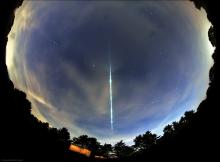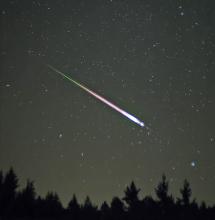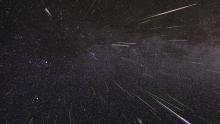Listen to today's episode of StarDate on the web the same day it airs in high-quality streaming audio without any extra ads or announcements. Choose a $8 one-month pass, or listen every day for a year for just $30.
You are here
Leonid Meteors
Meteor showers often are tales of good news and bad news. And that’s the case for this month’s Leonid shower, which should be at its best tonight. On the good side, the Moon is just past new, so it won’t get in the way of the fireworks. On the bad side, there won’t be that many fireworks to interfere with.
The Leonids are spawned by a comet, 55P/Temple-Tuttle. When the comet gets close to the Sun, some of its icy crust vaporizes. That releases small bits of dust and rock, which surround the comet. Over time, some of this “comet dust” spreads out along Temple-Tuttle’s orbit. Earth flies through this trail of debris every November. Some of the grains plunge into our atmosphere at high speeds. They quickly vaporize, forming the glowing slashes of light known as meteors.
The clouds of dust are thicker near the comet. So the Leonids are better when the comet is passing through the inner solar system. At those times, the shower can produce a “storm” of thousands of meteors per hour. That last happened a couple of decades ago.
Today, though, Temple-Tuttle is racing away from the Sun, so the showers are much less intense. This year, you might see a peak rate of a dozen or so meteors per hour, in the wee hours of tomorrow morning.
The lack of moonlight, though, at least ensures that you can see whatever meteors the shower produces. But you need a skywatching site with dark skies, away from city lights, to see the Leonid meteor shower.
Script by Damond Benningfield





